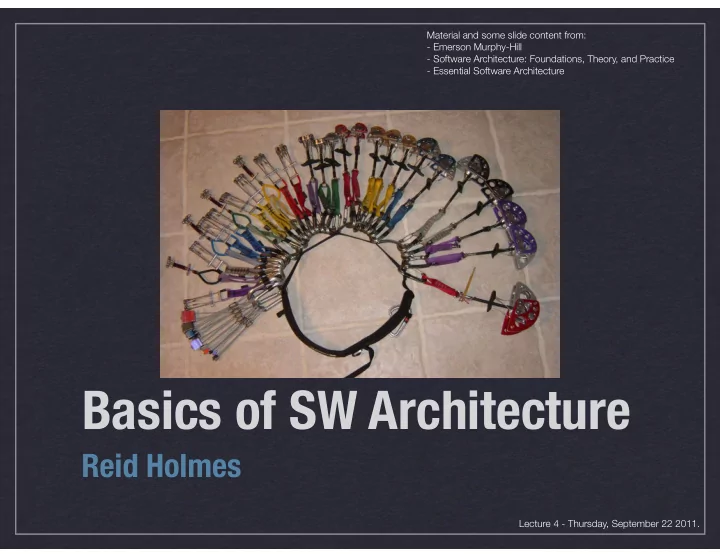

Material and some slide content from: - Emerson Murphy-Hill - Software Architecture: Foundations, Theory, and Practice - Essential Software Architecture Basics of SW Architecture Reid Holmes Lecture 4 - Thursday, September 22 2011.
Proposal Presentations ‣ Finish the last presentation. REID HOLMES - SE2: SOFTWARE DESIGN & ARCHITECTURE
Waterloo Event Finder Mike Ye Martin Lacombe REID HOLMES - SE2: SOFTWARE DESIGN & ARCHITECTURE
Main functionalities - Student REID HOLMES - SE2: SOFTWARE DESIGN & ARCHITECTURE
Main functionalities - Organizers REID HOLMES - SE2: SOFTWARE DESIGN & ARCHITECTURE
[TAILOR ET AL.] So what? ‣ What makes building systems so hard? ‣ Young field. ‣ High user expectations. ‣ Software cannot execute independently. ‣ Incidental difficulties [Brooks MMM]. ‣ Problems that can be overcome. (e.g., ...) ‣ Essential difficulties [Brooks MMM]. ‣ Those problems that cannot be easily overcome. REID HOLMES - SE2: SOFTWARE DESIGN & ARCHITECTURE
[TAILOR ET AL.] Essential Difficulties ‣ Abstraction alone cannot help. ‣ Complexity ‣ Grows non-linearly with program size. ‣ Conformity ‣ System is dependent on its environment. ‣ Changeability ‣ Perception that software is easily modified. ‣ Intangibility ‣ Not constrained by physical laws. REID HOLMES - SE2: SOFTWARE DESIGN & ARCHITECTURE
[TAILOR ET AL.] Attacks on Complexity ‣ High-level languages. ‣ Development tools & environments. ‣ Component-based reuse. ‣ Development strategies. ‣ Incremental, evolutionary, spiral models. ‣ Emphasis on design. ‣ Design-centric approach taken from outset. REID HOLMES - SE2: SOFTWARE DESIGN & ARCHITECTURE
[TAILOR ET AL.] Architecture Analogies ‣ We live in them. ‣ We know (approximately) how they are built. ‣ Requirements. ‣ Blueprints (design). ‣ Construction (implementation). ‣ Use in practice. REID HOLMES - SE2: SOFTWARE DESIGN & ARCHITECTURE
[TAILOR ET AL.] The architect ‣ Distinctive role. ‣ Broadly trained. ‣ Requirements, design, implementation, & use. ‣ Has a keen sense of aesthetics. ‣ Strong understanding of the domain. ‣ What are these for buildings? ‣ What are these for software? REID HOLMES - SE2: SOFTWARE DESIGN & ARCHITECTURE
[TAILOR ET AL.] The architect How is building architecture different from ‣ software architecture? What common benefits can software gain from an ‣ architect that a building gets from its architect? REID HOLMES - SE2: SOFTWARE DESIGN & ARCHITECTURE
What is SW architecture? ‣ Definition: “The set of principal design decisions about the system” ‣ Blueprint for construction and evolution. ‣ Encompasses: ‣ Structure ‣ Behaviour ‣ Interaction ‣ Non-functional properties REID HOLMES - SE2: SOFTWARE DESIGN & ARCHITECTURE
Prescriptive vs descriptive ‣ Prescriptive architecture dictates how the system will be built a priori . ‣ (as-conceived) ‣ Descriptive architecture captures how the system was actually built after the fact. ‣ (as-implemented) REID HOLMES - SE2: SOFTWARE DESIGN & ARCHITECTURE
Architectural degradation ‣ Drift ‣ Introduction of changes that are not captured in the current architecture but do not violate it. ‣ Erosion ‣ Introduction of changes that violate the current architecture. ‣ How can this happen? REID HOLMES - SE2: SOFTWARE DESIGN & ARCHITECTURE
Architectural recovery ‣ [ICSE 1999: Bowman, Holt, and Brewster] ‣ Conceptual architecture ‣ How developers think about the system. ‣ Focuses on meaningful relationships. ‣ Concrete architecture ‣ How the system was actually built. ‣ Necessary: the devil is in the details. REID HOLMES - SE2: SOFTWARE DESIGN & ARCHITECTURE
Components ‣ Elements that encapsulate processing and data at an architectural level. ‣ Definition: ‣ Architectural entity that: ‣ encapsulates a subset of functionality. ‣ restricts access via explicit interface. ‣ has explicit environmental dependencies. REID HOLMES - SE2: SOFTWARE DESIGN & ARCHITECTURE
Connectors ‣ Definition: ‣ An architectural entity tasked with effecting and regulating interactions between components. ‣ Connectors are often more challenging than components in large heterogenous systems. ‣ Often consists of method calls, but be much more. ‣ Examples? ‣ Often provide application-independent interaction mechanisms. REID HOLMES - SE2: SOFTWARE DESIGN & ARCHITECTURE
Configurations ‣ Bind components and connectors together in a specific way. ‣ Definition: ‣ An architectural configuration, or topology, is a set of specific associations between the components and the connectors of the system’s architecture. ‣ Differentiates a bag of components and connectors from an implementable system. REID HOLMES - SE2: SOFTWARE DESIGN & ARCHITECTURE
Architectural styles ‣ Some design choices are better than others. ‣ Experience can guide us towards beneficial sets of choices (patterns) that have positive properties. ‣ Such as? ‣ An architectural style is a named collection of architectural design decisions that: ‣ Are applicable to a given context. ‣ Constrain design decisions. ‣ Elicit beneficial qualities in resulting systems. REID HOLMES - SE2: SOFTWARE DESIGN & ARCHITECTURE
Recommend
More recommend